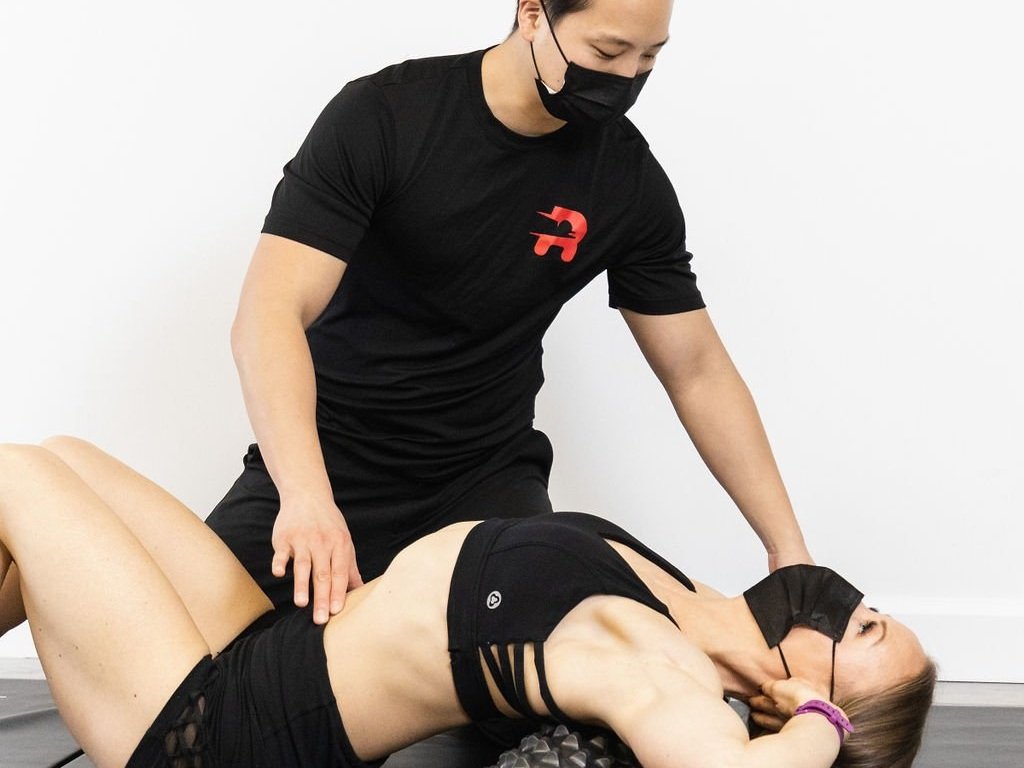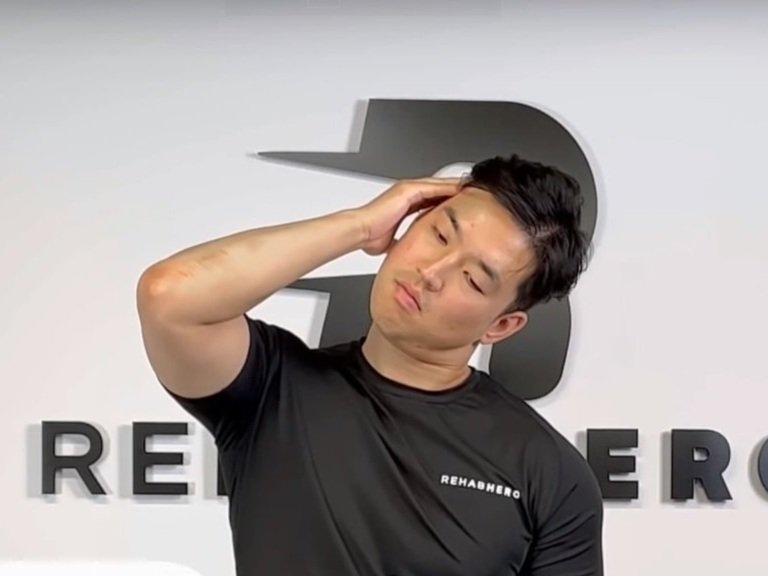Upper Trapezius Pain
Understand how to relieve upper trapezius pain
Learn about how this can be the cause of your neck stiffness and headaches
What is the anatomy of the upper trapezius?
The upper trapezius is part of a larger muscle called the trapezius. The trapezius is often divided into the upper, middle and lower fibers. The upper trapezius originates from the external occipital protuberance (EOP), nuchal line and ligament. It inserts onto the lateral third of the clavicle, acromion and the spine of the scapula (just above the origin of the deltoids). There are some anatomical variations where the clavicle insertion is at the middle of the clavicle (instead of distal third). It may also blend with the back edge of the sternocleidomastoid muscle as well.
It is innervated by the spinal accessory nerve (cranial nerve XI), and the ventral rami of C2-C4.
What does the upper trapezius do?
The upper trapezius is responsible for scapular elevation and retraction. It also works together with the lower trapezius fibers to facilitation up rotation of the scapula. When the scapula is stabilized it functions to laterally flex the head when contracted unilaterally, and to extend the head when contracted bilaterally. It is also responsible for stabilizing the shoulder blade during arm movements.
The trapezius is most active in the top 60 degrees of shoulder flexion and abduction and is responsible for generating strength in overhead motions (Olympic weight lifting, body building, etc).
What causes a tight upper trapezius?
It was previously believed that anterior head carriage and rounded shoulders, also known as upper cross syndrome, caused the trapezius to experience chronic overuse and postural fatigue syndrome. Postural fatigue syndrome (also known as trapezius myalgia) is due to repetitive overload of the upper trapezius associated with prolonged sitting at a desk or computer. It is also associated with holding a phone with your head and shoulder, large breasts, whiplash, and over training in sports.
What does upper trapezius pain feel like?
Depending on the nature of the injury, upper trapezius pain can vary. Acute strains are often painful with movement and may be sharp or dull. Range of motion may be limited due to pain intensity levels. Chronic strains may present as a dull ache, stiffness or tightness, and may even refer pain to adjacent regions like the head or mid back.
Trigger point referral can lead to pain over the neck and mastoid process, occiput and may be the cause of neck tension, neck aches or dizziness. Headache pain can reach the temples, back of eye and angle of the jaw.
The greater occipital nerve can be compressed through its pathway in the upper trapezius. This can also be a potential cause of muscle tension headaches.
How long does it take the upper trapezius to heal?
Healing times for the upper trapezius may vary depending on severity of the strain. Grade 1 strains may last 0 to 2 weeks. Grade 2 strains may last for 4 days to 3 months. Grade 3 strains may last for 3 weeks to 6 months.
How should I sleep with upper trapezius pain?
With an active upper trapezius strain, stretched positions tend to be aggravating in nature. Due to this, sleeping in positions that promote a neutral cervical and thoracic spine may be recommended. For those who sleep on their side, a pillow that can support the head without laterally flexing the neck should be used. Generally sleeping on the back is preferred over sleeping on the stomach due to neck positioning.
How do I loosen my upper trapezius?
Since the upper trapezius is responsible for laterally flexing the neck unilaterally, laterally flexing the neck to contralaterally will stretch the muscle. This means if you side bend your neck to the opposite side then you can stretch the upper trapezius. The Weight Assisted Neck Stretch is an example of this type of exercise:
How do you release upper trapezius trigger points?
Trigger points are regions of the muscle belly that refer pain to adjacent areas when compressed. These trigger points can reduce pain with ischemic compressions. Tools such as foam rollers or massage balls can be used to reduce perceived muscle tension or pain. An exercise that accomplishes this is the Doorway Upper Trapezius Active Release:
An alternative to the above exercise is to target the upper trapezius from back by doing the Upper Trapezius Active Release:
How do you strengthen the upper trapezius?
Since the upper trapezius is most active in overhead positions (top 60 degrees of shoulder flexion and abduction) and is responsible for scapular elevation and up rotation (shrugging motion), getting the muscles to activate in those positions can encourage muscle activation. An example of this exercise is the Overhead Shrugs exercise:
To stimulate a positive adaptation in the upper trapezius, progressive loading would be required. This can occur by loading up and overhead shrug motion. The purpose of strengthening the upper trapezius is to increase it’s capacity to handle prolonged load (minimizing fatigue). An example of this is the Lu Raise exercise:
Here is a short video on what you can do for ‘tight traps’:
How can physiotherapy help?
Pain in the upper trapezius muscle is a common problem that can be caused by a variety of factors, including poor posture, repetitive movements, and stress. Physiotherapy can be an effective treatment for reducing upper trapezius pain. A physiotherapist will assess the individual's symptoms and devise a customized treatment plan. This may include exercises, stretches, and massage. The physiotherapist may also provide advice on posture and ergonomics. With physiotherapy, it is often possible to reduce pain and improve function. In some cases, physiotherapy may be used as a preventative measure to reduce the risk of future problems.
How can massage therapy help?
Massage therapy is a popular and effective treatment for upper trapezius stiffness. RMTs use a variety of techniques to release tension in the muscles and fascia, improve range of motion, and reduce pain. Massage therapy can be especially effective in treating knots and trigger points in the upper trapezius. RMTs may use effleurage, petrissage, and trigger point release to release tension and improve muscle function. In addition, RMTs may use stretching and myofascial release to improve range of motion and reduce pain. Massage therapists will tailor treatments to each individual's needs.
How can chiropractors help?
If you suffer from upper trapezius myalgia, you know how debilitating the condition can be. The pain can make it difficult to perform everyday tasks, and can even impact your quality of life. Fortunately, chiropractic care can be an effective treatment for this condition. Chiropractors are trained to identify and treat problems with the musculoskeletal system. In the case of upper trapezius myalgia, chiropractors can use a variety of techniques to reduce pain and improve mobility. These may include chiropractic adjustments, massage, and stretches. If you are suffering from upper trapezius myalgia, consider seeking out a chiropractor for treatment.
Does acupuncture help?
Both traditional Chinese medicine acupuncture and Western medical acupuncture are popular treatment options for trapezius pain. Techniques including electroacupuncture, conventional acupuncture and dry needling can be used to target the trigger points of the upper trapezius. Additionally, acupuncturists may use techniques like Tui Na and Gua Sha to decrease muscle tone, reduce pain, and improve soft tissue mobility.
To book in an appointment with a Rehab Hero clinician in Markham or Toronto, click the button below.
Written By Dr. David Song
Dr. David Song is a chiropractor in Markham that has been in practice for 4 years. He has a keen interest in helping strength athletes optimize their performance through the use of customized exercise programming.




























